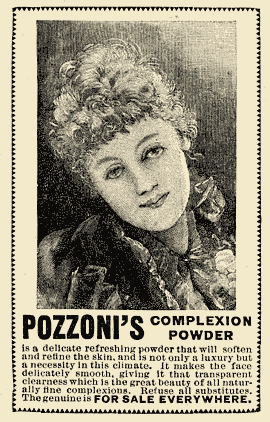An American Gaboriau
by Mary R. P. Hatch
Anna Katherine Green, the Author of “The Leavenworth Case” and Other Detective Novels.
Her First Story and Its Popularity — Extracts from Her Letters About Her Books.
How She Works — Two Years in Planning One of Her Successful Tales.
When the doughty Knickerbocker historian “voyaged to Haverstraw beyond the great waters of the Tappan Zee,” making classic as he passed the Palisades, Sleepy Hollow, and the profane regions of Spuyten Duyvil and Hell’s Gate, I suppose his mood may have been scarcely more adventurous than my own when, twenty years ago, I stood on the little Hudson steamer, the Chrystenah, bound for the self-same Haverstraw. It was almost my first trip to the great world and I was to mee that rara avis, an embryo authoress, who never doubted her ultimate success, though she had never had a line of her writings published outside her college paper.
As the Chrystenah swept up to the landing a tall, graceful girl, dressed in gray, with red berries in her hat, came forward to meet us, my cousin (her brother’s wife) and I.
She was scarcely older than myself, if of more assured womanhood. No premonition of friendship touched our first meeting, and I was quote content to be a listener, quiet and unused to her bright girlish chatter, as she related to my companion incidents and bits of travel; for she had just returned to Haverstraw from Poultney, Vt., the seat of Ripley College, of which she was a graduate.
We were always together in the months which followed, for a strong and enduring friendship, founded upon similarity of tastes and dissimilarity of temperaments, sprang up between us; and we shared the same room and the same pursuits. I soon learned that Miss Green had been writing tales and verses since she was 11. Ralph Waldo Emerson had just written her a letter, and so had Mr. Fields, and she was content to bide her time, which she knew would come, although her manuscripts came back to her with mathematical precision. A critic had said to her, “Keep out of the magazines if you can.” “If he had only known how hard I had tried to get into them,” she said, laughingly.
The girlish larks we indulged in, the costumes, quaint, ugly and curious, we dressed up in, the walks we took past the glaring brick yards, the outre characters we filched for our stories, the plans we sketched, the hopes we matured, the story we wrote together in which were forecast, on her part, the Leavenworth heroines—all this wells up from the fountain of memory as I write, but I pass it by for other matters.
Anna Katharine Green comes of a notable East Haddam, Conn., family. She is the daughter of James Wilson Green, at one time editor of the National Era (New York), and a lawyer of repute. From him undoubtedly his daughter inherits her legal turn of mind as evinced in her novels. Born under the very shadow of the Plymouth Church in Brooklyn, her environments may have fostered her literary aspirations, for they were manifested at an early age, and in as pronounced a manner as ever fell to the lot of genius. “After the removal of the family to Buffalo,” says Mr. Bigelow in the Magazine of Poetry, “when she was a mere child, she would walk the streets alone and recite to herself stories and verses of her own contriving.”
Many people believed “The Leavenworth Case” to have been her first start in the craft, but such was not the case. She served her apprenticeship in writing poetry and thus learned the art of expressing herself with grace, accuracy, and poetic finish. A prominent critic has lately recommended the same course to all writers of prose. Miss Green wrote all the verse which forms the two volumes of her published poetry before writing a single novel, and in those days called herself a poet only. “I eschew prose. Poetry is my forte; story telling is not possible to me, and now lies in an ignominious corner of my drawer,” she wrote the March following my return from New York.
“I am still writing with a good hope in my heart,” “I write from 9 a.m. to 5 p.m.” “I have not cut 500 lines.” “Last night a thought came to me and I wrote it down in the night.” For a young writer these extracts from her letters evince uncommon labor and care and a patience rare as remarkable.
She continued to write poetry—fiery, passionate verse, that thrilled the heart of public and critic, at last winning recognition as such poetry must. Her poems appeared in the Independent, the Century (then Scribner’s Magazine), Lippincott’s, and other periodicals. I will transcribe a little poem she sent me at this time, and which she afterward copied on the fly leaf of my volume of “The Leavenworth Case.”
SHADOWS
“A zephyr stirs the maple trees,
And straightway o’er the grass
The shadows of their branches shift;
Shift, Love, but do not pass.So, though with time a change may come
Within my steadfast heart,
The shadow of thy form may stir,
But can not, Love, depart.”
Can anything be more exquisite than these lines?
She sent from time to time extracts from all her long poems. To meet them between book covers was like greeting friends from whom one has long been severed, and in looking over her letters it was an actual pleasure to re-read her old-time words regarding her work, re-baptized for the public. “I am amusing myself by seeing how much I can put into eight lines,” she writes of “Pearls and Shadows.” Of “Paul Isham” “I shall not be surprised if you like it best of all.” When “Resifi’s Daughter” was published, three years ago, she wrote concerning it, “It is, I hope, the best piece of writingI have ever done,” but years before I had become familiar with the more notable parts. The masterpiece of the collection of poems is “The Tragedy of Sedan,” a fiery, rushing, seething, heart-rending poem. You are hurried through with bated breath and fast-beating heart. Sustained action! Why, it is sustained tempest.
“The Defense of the Bride” (and other poems) and “Resifi’s Daughter” almost upon publication took their place as successful, even without a dissenting voice from the critics, but instead much that was cheering. Harper’s Magazine characterized them as “vigorous productions,” possessing “masculine force and brevity,” etc. To know much of one thing one must be content to know less of others, and often to go through life with a mind veiled to the commoner things. The active brain of Miss Green holds many a talent which, better tended, might have blossomed into fame; but all has been cheerfully offered to the shrine of her muse, to feed the fires of her literary genius. An author can do no less, for he has as competitors not such as meet other craftsmen, those of his own day, his own city—maybe his own country, but authors of all times and climes, living and dead. A picture once painted stands forever and aye as an original. A book multiplies long after its creator is dead, and blocks the way before the new aspirant of literature. “But art life has its advantages,” she writes Aug. 22, 1880, “in what it does for our souls and our emotions. The world means more to the artist than to other people, for he is constantly following out the delicate threads of though, feeling, and action, tangling and untangling them, working himself back and forth through the labyrinth of circumstance and event, searching for the secret heart of all; the explanation of all, its source, power, and meaning.”
The dividing line between poetry and prose was reached in 1876, I think, when she wrote to me thus: “The other night I had a wonderful dream, which has impressed a story on my mind. * * * It is so passionate, so strong, so subtle, so dread, dark, and heart-rending, it ought to be written with fire and blood. It will require all my enthusiasm, study and power, and then I may fall short, but I believe I shall sometime try. Perhaps it is somewhat sensational, but I hope by characterization and earnestness to lift it to a higher ground.”
Faraday, the noted philosopher, is quoted as saying, in regard to novels, “I like the stirring ones, with plenty of life, plenty of action and very little philosophy. I want the novelist to supply me with incident and change of scene and to give me an interest outside of my own immediate pursuits.” One of Faraday’s favorite novels was “Jane Eyre,” “where a man,” he says, “keeps his mad wife at the top of his house. It is very clever and keeps you awake.”
This is the idea no doubt of many less distinguished people, and accounts for the popularity of writers like Charles Read, Wilkie Collins, Poe, Gaboriau, and Miss Green. People like to be kept awake, taken out of their immediate pursuits; and considered in this light, a work like “The Leavenworth Case” must bear off the palm before one of Howell’s or James’, which are the natural concomitant of leisure and culture, but not suited to the busy, who in an hour of entertainment seek the cup of self-forgetting excitement. Miss Green has received scores of letters which attest to the truth of these premises.
“It was written for the populace,” she wrote, “and while I can not help throwing into it some of my enthusiasm, I do not want you to think I have any hopes for it in the way of giving me favor. I had to stop and throw out this story before I could get leave to settle down to my life work of writing poetry. * * It absorbs me, and I can not help thinking it worth the labor bestowed upon it.”
“I never expected to be a prose writer,” she says later, on the eve of its publication, “and I find I have astonished my friends very much. I hope it will be a reasonable success if only to pave the way for my poems. The name of my novel is ‘The Leavenworth Case: a Lawyer’s Story.’”
It was accepted under the most favorable conditions by the first publishers who saw it, Messrs. Putnam’s Sons.
My copy arrived Thanksgiving Day, I recollect. I was astonished and delighted. I wrote and told her so, and she replied, “I was afraid it outre character would strike you unfavorably.”
From the moment of its appearance her success was assured; and at this point, it is interesting to note the author’s comments on her work—reasonable success, outre character. These were her words concerning the famous “Leavenworth Case.”
In another letter she wrote, “One ought not to expect much from a first effort. If I make anything of a start I shall do well.” As a pleasing contrast to her own estimate I must mention the fact that of sixty reviews which I read only one was unfavorable.
Of “A Strange Disappearance” she writes under date of Dec. 18, 1879: “My new book is out; my other one preparing for the stage, and all uncertain if success will attend the venture. As to ‘A Strange Disappearance’ I am quote encouraged, the first edition being nearly exhausted the first week. But what will the critics say? Ah, what!” “I presume you have read my book,” she writes later. “You will see that it makes no pretensions to be as elaborate as the other. The character of Luttra is the story’s excuse,” and Luttra would have been the title had her publishers approved.
The “Sword of Damocles” made its first appearance in 1881. “It is the fruit of much thought,” she wrote. “I conceived its plot and general plan immediately after the publication of ‘The Leavenworth Case,’ and then gave it two years of thought before putting pen to paper. The work contains two plots, and the characters range from the president of a bank to the most desparate of castaways. The first chapters have gone to press, and the last quarter of the book has not even been written. You see how I am driven and what a responsibility rests upon me.”
The reviews of the new book were for the most part satisfactory, but it never possessed the popularity of the other two, although and intensity of life runs through the events and it has many strong passages.
Her next long work was “Hand and Ring,” which first made its appearance in Frank Leslie’s Illustrated Newspaper, and was afterward brought out by the Putnams. The people who read it with such avidity little understood the confusing nature of the author’s task. “I am at work upon four parts of it at once,” she wrote. All through it she was driven to the last extremity, writing the last chapters for Leslie, arranging the first ones for the Putnams, and correcting proof for both, and this in hot July. “It seems strange not to be among the groves and trees, but,” she adds, gleefully, “I mean to have my outing yet.” Her books have appeared at quite regular intervals, ten in eleven years. She has just completed a novelette, and is engaged upon a longer work.
The same large scope, range, and intensity of feeling mark her works, whether verse or prose; the same directness, power, and dramatic finish; no magrims of the brain but fully developed, they invariably possess a forcible mastery of the subject. She deals with action, things, and motions. Humanity seems to her of more consequence than the world it exists in. If there is a lack in her prose it is in the descriptions of scenery; if superabundance in her poetry it is in the “fine excess,” of which, however, George Eliot says “we have need.” If in Miss Green’s later works one misses something of the intensity and dramatic interest of her earlier ones, there is noticeable on the other hand a more masterly characterization, a subtler rendering of motive. Of her methods of work she says: “In the first place, I do not create a story or plot—both come to me. I can not write unless I am vitally interested. My imagination may be stirred by some detail or situation, but until I am thoroughly acquainted with my people, their environment, the thoughts they think, the glances they give, in fact every little element that goes to make up their relationship to the drama in which they are cast, I sit and think, feel and dream, but do not write. * * * A sentence in the first chapter is conceived and wrought out to suit possibly the last sentence in the story. All is closely related, no word is written that has not its specific use in the makeup of my work. I proceed as one might to solve some abstruse problem, by clearly defined lines and deliberately planned steps.”
Though still Anna Katharine Green to the world, she is Mrs. Rohlfs to her friends. She resides in Buffalo, N.Y. in a charming home, made delightful by an appreciative husband and two fair children, Rosamond and Sterling. In appearance she is striking rather than beautiful, but the glory of her hair is a womanly crown. Unbound, it sweeps just to the floor when she stands erect.
Mrs. Rohlfs is a patient and careful writer, spending much time in elaborating her first ideas. Some chapters of “The Leavenworth Case” were rewritten as many as twelve times. “The literary career is a very demanding one,” she wrote two years ago. “If I succeed, it will be by dint of pure work. From morning to night, week in and week out, labor, labor, labor.”
Later words are these:
“I should not advise people to enter upon a literary life who were not driven to it by all the forces of their being. You have to fight, not one day, but a lifetime, to keep abreast of the crowd. Only a special talent, or a certain knack of putting old things in a new light, will insure one immunity from the conflict.”
Her theory in regard to novel writing is this: to have a story to tell, and then to tell it with force and directness, bringing to bear upon every part of it the most absorbing interest.
The exponents of her success have been unusually varied in this country and Europe. Her novels have been dramatized and translated into other languages, her songs have been set to music, but no success stirs her individuality from its equipoise of good judgment and strong common sense. She is bright, kind, and true, and has scores of friends.





